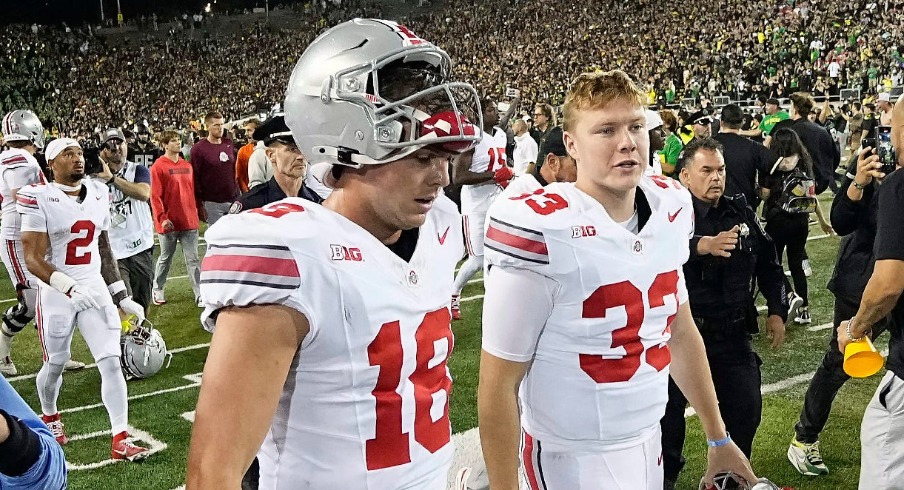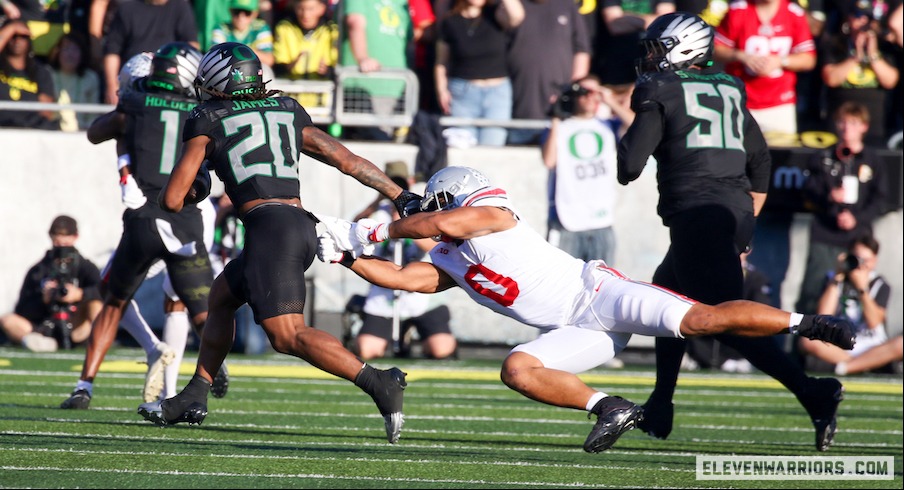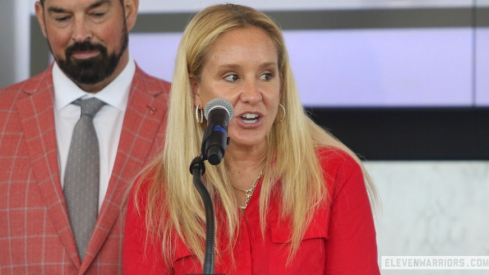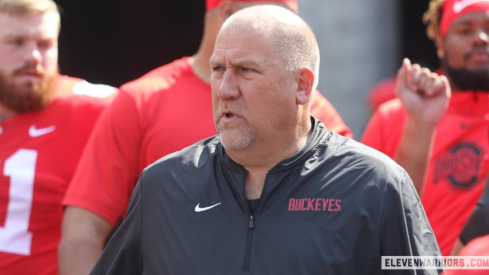In the agony of defeat, it remains important to reflect on mistakes.
Three Key Stats usually serves as a positive look back at which areas Ohio State numerically realized its most success during a given football game. However, following the Buckeyes' heartbreaking 32-31 defeat to the Oregon Ducks on the road Saturday night, fans must sift through the box score in search for answers to explain away such a loss.
We offer three key stats from the Buckeyes' first — and hopefully last — loss of the 2024 campaign.
No Starting Field Position Better Than OSU's 26-Yard Line
In his post game press conference, Oregon head coach Dan Lanning noted early on that two of his greatest points of emphasis to the Ducks coming into the evening were that they needed to beat their opponents on the ground and in the field position battle. While Oregon narrowly outrushed Ohio State on the night utilizing only a couple fewer attempts, the difference in starting field position between the teams served as a much more deciding factor in the result.
Six of the 11 total Buckeye possessions began at the Ohio State 25-yard line, and the only drive that started under friendlier circumstances began just a yard further out. The other four times OSU got the ball from Oregon, the offense took the field on its own 15, 21 (twice), and 2-yard lines.
Meanwhile, the Ducks' second possession of the game took place on their opponent's 28-yard line following a fumble by Quinshon Judkins, which Oregon promptly turned into a touchdown only two plays later. The hosts also began their next drive only nine yards away from midfield in their own territory.
Although that possession only resulted in a missed field goal, Oregon scored a touchdown on its following drive and then recovered an intentional onside/squib kick targeted at an Ohio State player. Five offensive plays starting from the Buckeye 41-yard line later, the risk paid off in three more points for the Ducks. Oregon's only touchdown of the second half also manifested on a drive that began from the team's 40-yard line.
The Buckeye offense only committed one turnover all evening, so how did Ohio State find itself so massively out-graced with respect to starting field position? A pair of defensive donuts offers some context towards the answer to that question.
Buckeye Defense Forces Zero Sacks or Turnovers
Prior to Saturday, one of the best developments regarding the dominance of the Buckeye defense so far this season was the resurgence of the Silver Bullets' pass rush. Ohio State recorded at least three sacks in each game this season and began conference play with back-to-back four-sack performances against Michigan State and Iowa, which matched the highest total the team had in any Big Ten game last season.
Against Oregon, the pass rush failed to bring down Dillon Gabriel once on any of his drop backs. The result served as only the third time across the last three seasons that the Buckeyes have failed to record a single sack in a contest. The previous blanks manifested in last season's dramatic win on the road against Notre Dame and 2022's victory over Northwestern largely compromised by windy weather that made throwing the ball almost impossible for either side.
The more concerning trend for this defense would appear to be the lack of consistent turnover production under Jim Knowles. Shockingly, Saturday's result ended up as the third game of Ohio State's six so far this season that did not yield either a fumble recovery or interception for the Buckeyes. OSU also failed to do so in seven games last season. Across all 32 contests in which Knowles has functioned as Ohio State's defensive coordinator, his unit has failed to record a turnover in an alarming 15 of those games.
For a defense that many expected to realize itself as the best in college football heading into this season, that trend simply cannot persist. Knowles' positive impact on that side of the ball relative to his predecessor remains obvious, but for a program with National Championship aspirations, the areas of necessary improvement also appear clear.
Ohio State Draws Eight Penalties to Oregon's Three
Winning any football game proves difficult enough when a team loses on field position and turnover margin. Getting beaten on penalties further makes the pursuit of victory almost impossible.
In that sense, it seems highly fortuitous that the Buckeyes found themselves in position to take back the lead on the final drive of the game despite ultimately finishing the evening with nearly three times as many penalties as their opponent. OSU ended the game with eight penalties for 70 yards, while the Ducks saw only three flags for a total of 25 yards.
Ohio State has now found itself penalized for more yards than the opposing school in all six of its games this season. Only against Marshall did OSU earn less flags than the other team.
While any penalty can result in a drive-killing or defensively-crippling momentum swing at any moment of a given game, two of the most controversial for each side occurred on Saturday's final drive. Shortly after a massive catch by Emeka Egbuka put the Buckeyes into realistic field goal range during the final minute, Jeremiah Smith drew a highly controversial offensive pass interference foul that pushed OSU back from Oregon's 28 to the 43-yard line.
At that point, the Ducks had only drawn a pair of flags themselves for just 20 yards. Lanning called a timeout with 10 seconds left on the clock and then curiously saw his defense flagged for a five-yard illegal substitution penalty that saw 12 Oregon personnel successfully force an incompletion by Will Howard that drained four seconds off the clock.
College football fans across America immediately began to speculate that Lanning had intentionally committed such an infraction to manipulate the remaining game clock in the Ducks' favor. Howard ran out of time scrambling into field goal range on the next snap before he could get down for an Ohio State timeout and field goal try.
you NEED to watch how genius this is
— Warren Sharp (@SharpFootball) October 13, 2024
:10 left, Oregon calls a timeout
they intentionally add a 12th man late to ensure no big gain occurs
ball is snapped, no big gain
obviously its a penalty BUT
1) :04 ticks off clock
2) no big gain
:06 left
only time for 1 play
WIN pic.twitter.com/2MouQanBK8
Some folks further theorized that Lanning had implemented a form of what former two-time Super Bowl-winning defensive assistant coach Buddy Ryan referred to as a "Polish goal line defense." Ryan's tactics effectively called for purposefully getting penalized by running a play with three extra linebackers on the field to draw a half-the-distance penalty while draining the clock and ensuring a lack of offensive progress. The play following the flag, the extra defensive personnel would return to the sideline and the offense would only have enough time to execute one snap for a score.
dan lanning accidentally ran buddy ryans polish goalline defense to win pic.twitter.com/A46zzXEiY2
— Brian Floyd (@BrianMFloyd) October 13, 2024
This sort of gamesmanship actually led to a rule change following the 2019 NFL season after former New England Patriots head coach Bill Belichick deployed similar tactics to run down the clock during a blowout win on Monday Night Football over the New York Jets. When the Patriots faced the Tennessee Titans later in that season's Playoffs, former Titans head coach Mike Vrabel turned the tables on Belichick and utilized a similar approach to the great displeasure of the latter.
Bill Belichick got so mad when he got Bill Belichicked by Mike Vrabel. pic.twitter.com/su5cqa5iqX
— Michael Hurley (@michaelFhurley) January 5, 2020
Regardless of belief about these rule changes eventually needing adoption into college football, Buckeye fans can all agree that the theme of losing on penalty yards cannot continue for Ohio State. Lanning softly hinted after the game about the possibility of a rematch between these teams later in the season should OSU continue to compete. However, Ryan Day will have to make certain the aforementioned negative trends surrounding the Buckeyes get corrected before then for such a meeting to take place.
- #3 Oregon 32, #2 Ohio State 31
- • Buckeyes Fall to Ducks, 32-31
- • Defense Not Outstanding "In Any Area"
- • OPI, Late Slide Derail Final Drive
- • Josh Simmons Likely Out for the Season
- • Ohio State Postgame • Oregon Postgame • Photos • After Carmen
- • Five Things • Notebook • Social Reax • Three Key Stats



